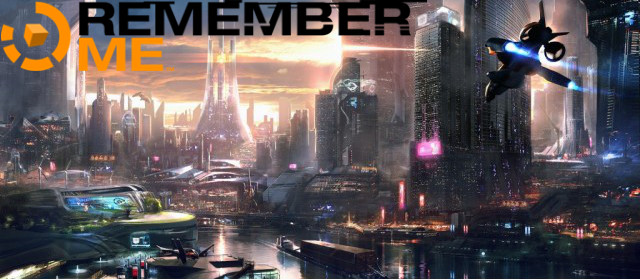How many times have you woken up in the morning with only vague sense memories of the night before and an unexplainable feeling of abject embarrassment? More than you’d like to admit, right? Chances are, you told yourself on those occasions that if you can’t remember it, it didn’t really happen. It’s the old “tree falling in the forest with no one to hear it” conundrum. But, what if you could store fresh memories as you formed them, and then download them later to cure such short-term amnesia? Would you even bother? Probably not – but such an application would have limitless possibilities, far beyond reconstructing the lost memories of a drunken night out.
In the future world of Remember Me, memories are a commodity. You can share them with others, allowing your spouse to experience the exact moment you fell in love with them, for instance, or allowing someone else to live the once-in-a-lifetime adventure holiday you just took. You can visit vending machines and pay money to relive periods of your own past – a Godsend for those who have lost a loved one or are living their real life in the gutter. If you’re a Memory Hunter, you can steal memories, using a special tool to hack into a person’s subconscious just like hacking a computer, in order to retrieve specific information to sell to the highest bidder. If you’re really good at it, you can even alter a person’s memory, changing subtle yet crucial details to switch their perception of past events. It’s called Memory Remixing, and Remember Me’s protagonist, Nilin, is a master of the art.
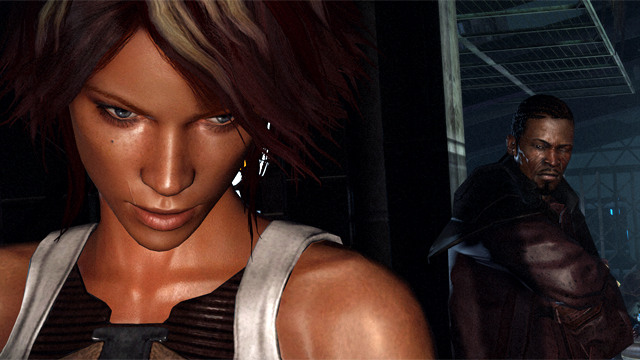
As the narrative opens, Nilin (voiced by Welsh actress Kezia Burrows) is imprisoned in the Bastille, a high security penitentiary in Neo Paris where inmates are incarcerated without their memories. Taking control, you must escape the Bastille with the help of “Errorist” leader Edge, a revolutionary whose rebellion against memory control is in dire straits after a crackdown by the authorities. Escaping the Bastille without her own memory, Nilin is soon back in action, hunting memories according to Edge’s instructions. Although Nilin’s primary motivation is the restoration of her own mind, Edge appears to have other ideas, using her as a weapon and a pawn in the Errorist cause.
The main drive of the plot is the Errorist agenda to bring down Memorize, the global corporation that controls the manufacture and distribution of “Sensen implants”. The “Sensation Engine” enables people, through their spinal implants, to access their subconscious for the manipulation of memories. It also allows corporations to advertise to the individual using imagery that only they can see (it makes for an interesting game world as you walk around and see signs and adverts represented as floating text or images). Crucially, though, Sensen technology allows those with the know-how to hack people and control their actions. It’s this application of the science that the Errorists are railing against – though necessity dictates that they fight fire with fire.
The narrative itself is solid, but the lack of a clearly established villain means it takes a while to find its feet. Nilin is the kind of character who needs a nemesis. She’s powerful, talented and hard as nails, but without someone to rage against she’s often left floundering in the dark, always looking for someone to fight against but having to settle for henchmen and masochists who she generally kills five minutes after meeting. Several plot twists come out of the shadows to sucker punch you while you’re distracted by the pretty lights, but it would have been great had DONTNOD given Nilin someone to focus her amnesiac frustrations on. Also, despite several attempts to make you care about the lesser characters, the only one who really matters throughout is Nilin. She’s noble yet conflicted, and because she’s unable to remember a past that all evidence suggests may have been more than a little unsavoury, she struggles with some of the assignments Edge gives her (on a moral level, at least). Thankfully, at a certain point around the halfway mark, the story begins to really take shape before gathering pace towards a surprisingly emotional finale.
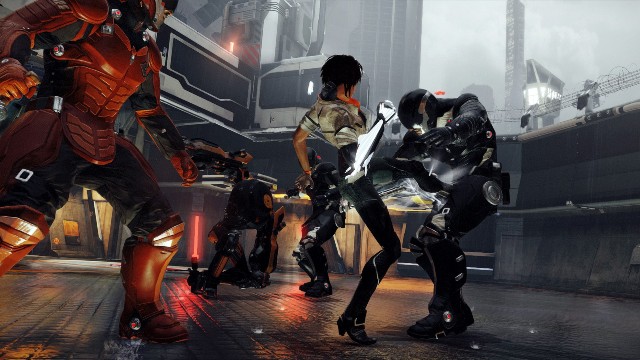
Along the way Remember Me marries western action adventure with the kind of game design for which Capcom are best known, producing an experience that feels like Tomb Raider or Uncharted when you’re moving Nilin around, but has echoes of Resident Evil and Devil May Cry here and there. Being a spry, wiry type, Nilin is unafraid to use verticality to get where she wants to be. She climbs, jumps, slides, and generally slings herself around the neon cityscape of Remember Me’s world like a lithe, skulking feline. Grab-points are highlighted with Sensen markers, making traversal a cinch, and the platforming is accurate and responsive throughout. The connection to Resident Evil is subtle, but evident in the occasional puzzles Remember Me throws up. Riddles to crack door codes and physical puzzles are few and far between and, while they don’t seem out of place, as such, they certainly feel more like they’ve been included as homage to something else rather than as an essential part of Remember Me.
All the memory tampering is made possible by Nilin’s glove, a sophisticated device that allows her to hack and overload Sensen implants, manipulate machinery and stun her enemies. When Nilin first acquires the glove along with her “combat skin” from an old ally, it has limited uses, but as you progress through the story it will upgrade into a multipurpose tool called the “Spammer” that can activate switches, overload circuitry, allow you to move things like elevators and emergency doors, and transfer power from one switch to another. Of course, its primary application is manipulation of a person’s recollection, and it’s through this particular talent that Nilin is able to take you inside a person’s mind to “Remix” their memories.
Used sparingly enough to remain cool throughout the entire narrative, Memory Remixing entails entering a target’s subconscious and changing subtle yet significant details to alter their version of events (an example is when Nilin remembers once convincing a person that he murdered his wife in order to push him toward suicide). The selected memory is presented as a stylised pastiche, and will first play through the events as they actually happened, after which you can rewind back to the start and make a variety of changes, highlighted by visual glitches telling you when to stop the replay. Altering the correct elements in the correct order is the only way to proceed, as an incorrect sequence could lead to a “memory bug” and force you to start all over again. Had the fail state resulted in the story taking different paths, the Remixes would have felt more impactful, but as it is they’re really just a different kind of puzzle. That said, they’re presented in a way we haven’t seen before, and every one requires concentration and brainpower to crack, making them an enjoyable aspect of the gameplay.
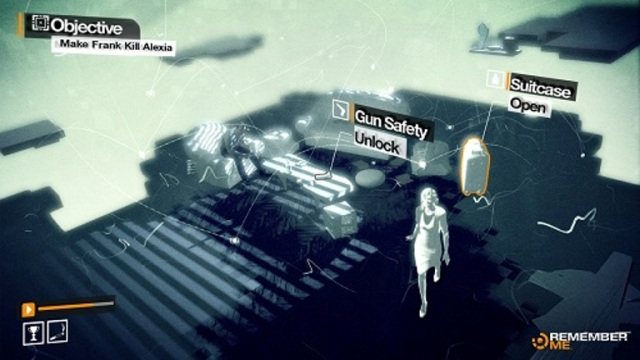
At times you’ll be given a target whose memory you need to steal in order to progress. While the chase and subsequent theft are scripted into the narrative, they usually lead into a stealth or puzzle section where you follow Remembranes, signatures left behind that create ghosts for you to follow. You might be required to synchronise with the Remembrane to hack a door or terminal, or to follow it to avoid landmines or patrolling security drones who will trigger an instant reload if they catch you. These moments are a nice aside to the running and jumping, and prevent monotony from setting in.
Besides the platforming and memory-games, the main component of Remember Me is the combat – and there’s a lot of it. The melee is unique in that the combos are put together by you, and can be changed to suit your needs whenever required (even mid-fight). By opening up the Combo Lab you’ll have access to four types of attack known as Pressens. Red “Power” Pressens deal higher damage, yellow “Regen” Pressens restore a little health, purple “Cooldown” Pressens reduce the amount of time it takes to reuse an S-Pressen (more on those in a moment), and blue “Chain” Pressens repeat the previous move with added kick. All attacks are mapped to either Square or Triangle (or X and Y if you’re on 360, natuarally), making the combat easy to get to grips with and incredibly adaptable. And it needs to be, too, as the variety of enemies per fight is often staggering.
You have the devastating S-Pressens to back you up, though: five attacks that can tip the balance of almost any fight, provided you use them in the right place and have at least one full block of Focus (the energy required to use an S-Pressen). They include Fury, which increases Nilin’s damage output and allows her to leap from enemy to enemy like a hyperactive lemur; the Logic Bomb, that attaches to one enemy and activates a powerful area of effect explosion; and Rust in Peaces, a ranged attack that turns robotic enemies against their allies. All have cooldowns that last upwards of a minute, so you’ll need to use them in conjunction with cooldown-heavy combos if you want to maximise their effectiveness – particularly as certain enemies are incredibly hard to kill without them.
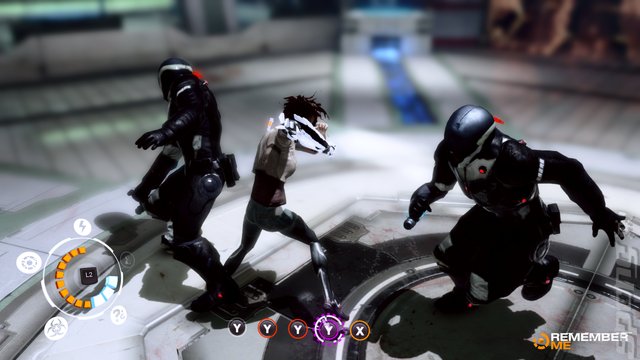
Remember Me is not afraid to make you swear, and even the most patient player will occasionally become frustrated with some of the larger encounters, mostly due to the crazy mix of tactics you’ll often need to employ. Leapers are addled-memory addicts analogous to modern-day junkies, but inhumanly fast and agile, who can cling to walls and dive-bomb you, turn completely invisible under shadow or, in the case of Skinners, feed off their smaller brethren. SABRE commandos are human enemies who also come in a variety of types, some with shields, some with batons that can activate the cooldown on all of Nilin’s S-Pressens, some with forcefields that reflect all the damage you deal back onto you. Then there are robots, from the flying Nephilim to the gargantuan Zorn, who can’t be combo’d and need a combination of S-Pressens and the Spammer to destroy.
When Remember Me is feeling really cruel, it will set out to make you feel inadequate and, on more than one occasion, it will succeed. That said, you are given the tools required to get by. Earning PMP (Remember Me’s equivalent of XP) will unlock new Pressens, and eventually you’ll be able to perform an 8-hit combo. A clever sequence of all four Pressen types will see you through even the tougher fights, and being able to change each combo on the fly is a major plus when you’re getting roundly trounced and need to make an entire combo out of cooldown and regen Pressens.
To begin with, the combat in general can be frustrating, but after a certain point you’ll have enough Pressens and knowledge of the mechanics that things will click into place. Of course, this being a Capcom game, there are several boss fights spread throughout the narrative, and each one is very different. They follow the standard modus operandi of pattern recognition and attack repetition, but some of them are incredibly tense affairs that will likely test the limits of your patience. None of them are insurmountable or particularly unfair, but none can be classed as easy, either.
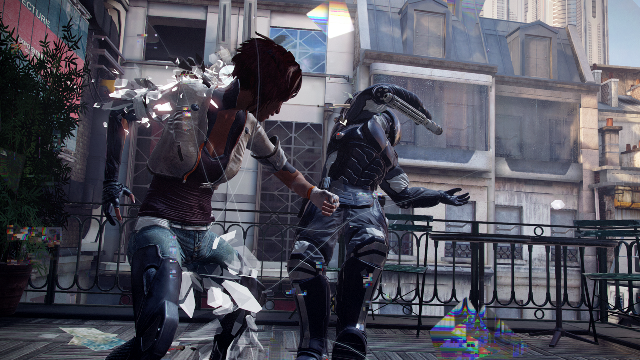
Outside of the melee, exploration is rewarded with collectibles in the form of “Mneist” pick-ups that act like Codex entries to fill in back story on the world and its technology, or hidden Scaramechs that can be shot with the Spammer to provide a PMP boost. You’ll also find SAT Packs and Focus Boosts, five of which will add a block of health or focus, respectively. The location of certain pick-ups is revealed in memory signatures left behind by other Errorists that act as visual puzzles and clues to help you along your way. Even though you can never wander far off the beaten path, exploration is always a joy because of how beautiful and well-realised the world is.
Neo Paris, 2084, is a dazzling city. As with all gaming dystopias, it’s a place split cleanly in two, one half a brightly-lit, upper-class paradise of glass and chrome, the other a grimy cesspit of filthy sewers, litter-strewn crack alleys and societal waste. The contrast is stark and affecting, and the meticulous environmental detailing is exquisite, even if it is very occasionally marred by the odd spot of texture pop-in.
The art style is gorgeous, lending Remember Me its own unique identity. The stark white and orange symbols that light Nilin’s path in a variety of ways from switches to grab-points are striking, and Sensen technology gives every displayed help message a contextual right to exist, neatly sidestepping any potential immersion issues. The colour palette is glorious throughout, and the style of the character models evokes a strong sense of place and time. Nilin looks fantastic – sexy, yes, but not shamefully so; she looks every inch the acrobatic pugilist she is, and it’s worth noting that her outward sexuality is never played upon. She never has to be rescued by a stronger male saviour, nor use her “feminine charms” to get the job done – something that would wholly refreshing if Crystal Dynamics’ Tomb Raider hadn’t already reinvented the strong female lead back in March.
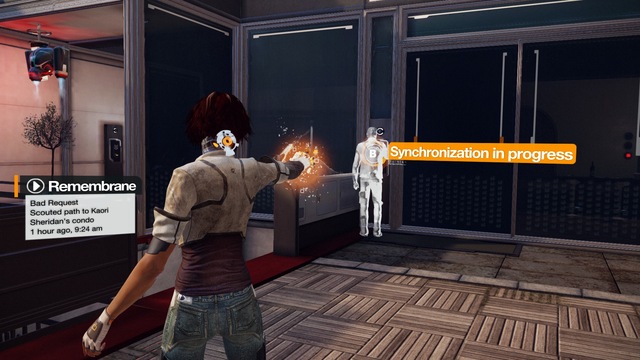
The aesthetics and audio combine to immerse you in Remember Me’s imperfect future world at all times, but there are minor problems with some of the voice cast not quite hitting the right cadence, and sometimes it’s almost as though the script was written by two different teams in two different places at two different times. The main story elements and cut-scenes are wonderfully scripted – Nilin’s monologues in particular standing out – but some of the incidental dialogue, especially during fights and chases is dangerously close to cheesy. It’s not a major complaint, but it did jar me more than once.
VERDICT: As a debut release, Remember Me is an absolute triumph for DONTNOD, though perhaps Capcom had a little too much creative input in places (the puzzles and boss fights, for instance). That said, the Combo Lab and Memory Remixing are two exceptional highlights that separate Remember Me from the crowd of action adventures released this generation. Some will struggle with the combat here and there, and the puzzles arguably don’t need to exist, but on the whole it’s a fantastic experience that will stay in your memory long after you’re done.

SUPERB. This is the mark of greatness, only awarded to games that engage us from start to finish. Titles that score 9/10 will have very few problems or negative issues, and will deliver high quality and value for money across all aspects of their design.


